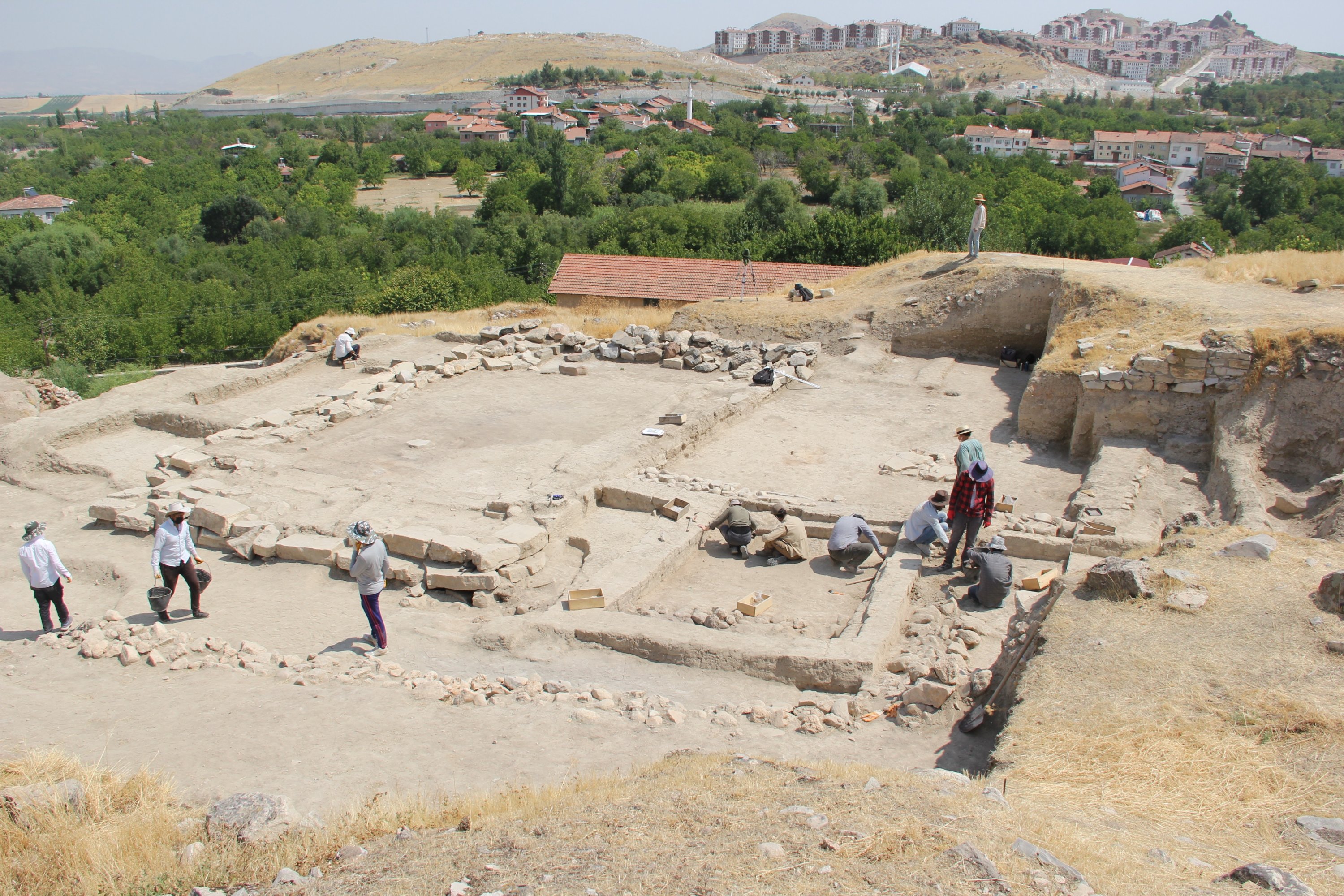Anthropology
Related: About this forum5,500-year-old houses, tombs found in Turkey's Arslantepe
BY DEMIRÖREN NEWS AGENCY
MALATYA, TURKEY ARTS AUG 27, 2021 3:56 PM GMT+3

A general view from the excavations at the archaeological site of Arslantepe, Malatya, eastern Turkey, Aug. 18, 2021. (DHA Photo)
In the archaeological site of Arslantepe, which is 7 kilometers (4.34 miles) away from eastern Turkey’s Malatya province, 28 tombs thought to date back 1,000 years and the remains of four houses that are estimated to be 5,500 years old were found.
One-third of this year's excavations have been completed in Arslantepe, which was recently included in UNESCO's Cultural Heritage Permanent List.
The Arslantepe archaeological site served as a settlement from 5,000 B.C. to the 11th century A.D. It was used as a Roman village during the fifth and sixth centuries A.D. and later served as a Byzantine necropolis. The site hosts various findings related to the birth of a state system and the transition from an egalitarian social structure to a hierarchical one. In excavations in past years, the world's first rain drainage line, a mud-brick palace, sculptures of lions and an overthrown king, and more than 2,000 seals were unearthed in Arslantepe.
Excavations in Arslantepe started this year on Aug. 10 with a team of 55 people. As part of the recent works in the site, 28 tombs estimated to date back 1,000 years and to the medieval period were discovered. On the side of this area, the remains of four houses, which are thought to be from 5,500 years ago, were found side-by-side as well.
More:
https://www.dailysabah.com/arts/5500-year-old-houses-tombs-found-in-turkeys-arslantepe/news
Dream Girl
(5,111 posts)Will save this to read later.
Judi Lynn
(162,753 posts)Predating Stonehenge by 6,000 years, Turkey’s stunning Gobekli Tepe upends the conventional view of the rise of civilization

Now seen as early evidence of prehistoric worship, the hilltop site was previously shunned by researchers as nothing more than a medieval cemetery. (Berthold Steinhilber)
By Andrew Curry
SMITHSONIAN MAGAZINE | SUBSCRIBE
NOVEMBER 2008
Six miles from Urfa, an ancient city in southeastern Turkey, Klaus Schmidt has made one of the most startling archaeological discoveries of our time: massive carved stones about 11,000 years old, crafted and arranged by prehistoric people who had not yet developed metal tools or even pottery. The megaliths predate Stonehenge by some 6,000 years. The place is called Gobekli Tepe, and Schmidt, a German archaeologist who has been working here more than a decade, is convinced it's the site of the world's oldest temple.
"Guten Morgen," he says at 5:20 a.m. when his van picks me up at my hotel in Urfa. Thirty minutes later, the van reaches the foot of a grassy hill and parks next to strands of barbed wire. We follow a knot of workmen up the hill to rectangular pits shaded by a corrugated steel roof—the main excavation site. In the pits, standing stones, or pillars, are arranged in circles. Beyond, on the hillside, are four other rings of partially excavated pillars. Each ring has a roughly similar layout: in the center are two large stone T-shaped pillars encircled by slightly smaller stones facing inward. The tallest pillars tower 16 feet and, Schmidt says, weigh between seven and ten tons. As we walk among them, I see that some are blank, while others are elaborately carved: foxes, lions, scorpions and vultures abound, twisting and crawling on the pillars' broad sides.
Schmidt points to the great stone rings, one of them 65 feet across. "This is the first human-built holy place," he says.
From this perch 1,000 feet above the valley, we can see to the horizon in nearly every direction. Schmidt, 53, asks me to imagine what the landscape would have looked like 11,000 years ago, before centuries of intensive farming and settlement turned it into the nearly featureless brown expanse it is today.
Prehistoric people would have gazed upon herds of gazelle and other wild animals; gently flowing rivers, which attracted migrating geese and ducks; fruit and nut trees; and rippling fields of wild barley and wild wheat varieties such as emmer and einkorn. "This area was like a paradise," says Schmidt, a member of the German Archaeological Institute. Indeed, Gobekli Tepe sits at the northern edge of the Fertile Crescent—an arc of mild climate and arable land from the Persian Gulf to present-day Lebanon, Israel, Jordan and Egypt—and would have attracted hunter-gatherers from Africa and the Levant. And partly because Schmidt has found no evidence that people permanently resided on the summit of Gobekli Tepe itself, he believes this was a place of worship on an unprecedented scale—humanity's first "cathedral on a hill."
With the sun higher in the sky, Schmidt ties a white scarf around his balding head, turban-style, and deftly picks his way down the hill among the relics. In rapid-fire German he explains that he has mapped the entire summit using ground-penetrating radar and geomagnetic surveys, charting where at least 16 other megalith rings remain buried across 22 acres. The one-acre excavation covers less than 5 percent of the site. He says archaeologists could dig here for another 50 years and barely scratch the surface.
More:
https://www.smithsonianmag.com/history/gobekli-tepe-the-worlds-first-temple-83613665/
(How exciting, visiting Turkey! Wow!)